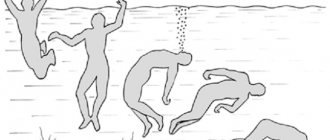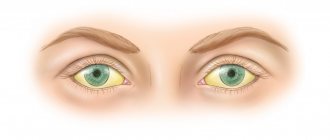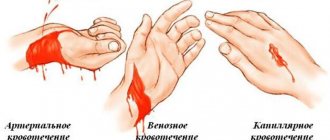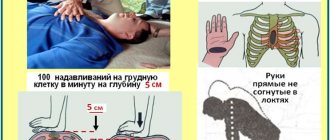All acute allergic reactions requiring emergency care are divided into two groups: generalized - anaphylactic shock and toxic-allergic dermatitis (Stevens-Johnson syndrome, Lyell's syndrome); and localized - cutaneous (urticaria, angioedema or Quincke's edema).
Anaphylactic shock is an acutely developing, life-threatening pathological process caused by an immediate allergic reaction when an allergen is introduced into the body. Anaphylactic shock develops rapidly, a few seconds or minutes (usually no more than 30 minutes) after contact with the “causal” allergen (usually in response to the administration of medications, during provocative tests, or insect bites). The most important role in the development of shock is played by a high degree of sensitization of the body.
How does anaphylaxis occur?
When an allergen enters the body, the immune system begins to produce immunoglobulins. The body increases sensitivity to the effects of foreign substances and allergens, which manifests itself in the form of swelling, itching, and low blood pressure.
When the human body encounters an allergen for the second time, anaphylactic shock may occur. Immunoglobulins recognize a foreign substance (allergen), and mediators are released by immune cells in large quantities, which causes an allergic manifestation that is already tangible to a person.
In the absence of qualified medical care, death can occur.
How does anaphylactic shock occur and occur?
- When an allergen enters the human body, cells actively begin to release histamine, which leads to an immediate hypersensitivity reaction.
- The appearance of histamine in the blood is accompanied by vasoconstriction, as a result of which internal organs do not receive sufficient nutrition and do not function fully.
- It is noteworthy that hypoxia also affects brain cells, as a result of which the victim experiences acute feelings of fear/anxiety and clouding of consciousness.
- If immediate medical attention is not provided, it can cause death due to suffocation or cardiac arrest.
What causes anaphylactic shock?
Any substance can become an allergen. Allergic reactions accumulate in the body and the range of active camponetes expands. If there have already been manifestations of allergies, then an allergist and immunologist is needed to prevent unexpected and sad consequences in the near future.
The following may cause a reaction:
Medicines
For example:
- Medicines for the treatment of bacterial infections;
- Medicines that reduce skeletal muscle tone;
- Anesthetics;
- Vaccines.
Meat products may contain muscle relaxants and cause a reaction.
Insect bites . If a person is bitten by insects such as wasps or bees, anaphylactic shock may occur.
Food. The most allergenic include citrus fruits, milk, seafood, nuts, and various food additives.
Pollen. Flower or grass pollen can cause anaphylaxis.
Helminths. Parasitic diseases often cause an allergic reaction caused by waste products of helminths.
Too intense muscle work. Strenuous athletic training can cause anaphylaxis. Especially in combination with the use of various types of medications.
The main causes of anaphylactic shock
The causes of the occurrence and course of anaphylactic shock for each person are of a purely individual nature. An insect bite or contact with household chemicals, cigarette smoke and spicy foods, medications and animal hair are just a small list of allergens that can cause anaphylaxis in a person.
To avoid its occurrence, always carry first aid medications (antihistamines) with you.
Tell your colleagues and family about the signs of shock and emergency first aid. This article is for informational purposes only, please consult your doctor for details! Ask your doctor about contraindications and side effects.
Symptoms of anaphylaxis
When an allergen enters the human body, the reaction may be immediate or may occur within a few minutes.
The severity of the reaction depends on the time it occurs after contact with the allergen. The sooner the onset, the more severe the reaction itself will be.
First symptoms:
- the appearance of fear of death;
- heat, itching;
- swelling;
- weakness, lethargy, malaise, loss of consciousness;
- asphyxia, suffocation;
- low pressure.
Anaphylaxis can develop in different ways:
- breathing is impaired - narrowing of the lumen of the small bronchi, narrowing of the larynx, Quincke's edema;
- disruption of the gastrointestinal tract;
- convulsions, severe nausea, urinary incontinence;
- pain in the heart area, rapid heartbeat, sharp decrease in blood pressure.
The number of allergens received by the body does not matter. A severe reaction can be caused even by small doses.
Anaphylactic shock - first aid
07.05.2021
Anaphylactic shock is a manifestation of an allergy an allergen enters the body again , which is associated with hypersensitivity of the body. In other words, we can say that this is an allergic reaction , which develops quickly and with the maximum manifestation of all symptoms.
Most often, an anaphylactic reaction occurs in response to the administration of medications, although it can also occur with food, honey, insect bites and much more. The route of administration of the allergen does not matter: it can be intravenous administration of the drug, or inhalation of the allergen , or by cutaneous application.
an allergen enters the body for the first time, the immune system remembers it and creates cells that, when it enters the body again, activate all protective reactions. Therefore, when exposed to an allergen , there is a massive release of biologically active substances, hormones and mediators, which constitute the clinical picture of anaphylactic shock .
An anaphylactic reaction develops quickly, within minutes or hours.
The first symptoms are localized in the place where the allergen . If the drug is administered by injection, then redness, swelling of the tissue at the injection site, itching and burning occurs. The redness spreads quickly, literally before our eyes . If the allergen enters through the oral cavity, the soft tissues of the mouth , the tongue enlarges, and the swelling quickly covers the entire face . The face is hyperemic and puffy. There may be cramping pain in the abdomen . Swelling quickly moves from the skin and visible mucous membranes to the internal organs. On the part of the respiratory system, difficulty breathing, shortness of breath, spasm of the glottis and bronchial lumen develop, which manifests itself in the form of laryngospasm and bronchospasm. The person feels short of air, gasps for of the face appears . From the cardiovascular system, peripheral circulation is impaired, which is manifested by a feeling of numbness in the fingertips and fainting. A sharp decrease in blood pressure.
First aid for anaphylactic shock
- Eliminate the effect of the allergen ; if this is an injection of a medication, then stop administering it. If the clinical picture develops outside a medical institution, then it is necessary to urgently call an ambulance, because anaphylactic shock is not a condition that needs to be treated at home on your own.
- If there are glucocorticoids or antihistamines at home, then they must be administered in any possible way (intramuscular, intravenous or orally ) . Representatives of glucocorticoids: hydrocortisone, prednisolone (at a dose of at least 150 mg) or dexamethasone (20 mg). Antihistamines - diphenhydramine or suprastin 1 ml.
- Adrenaline is a first-line drug because it not only eliminates vascular reactions, but also blocks the production of histamine, the main mediator of the allergic reaction . 1 ml of adrenaline hydrochloride is diluted in 10 ml of physiological solution, administered slowly in 1 ml increments over a period of time until the patient’s condition improves.
- If there is difficulty breathing, aminophylline 2.4% is administered in a dose of up to 20 ml. This drug relieves spasm and expands the lumen of the bronchi.
- Intravenous administration of solutions to reduce the concentration of biologically active substances in the blood and reduce symptoms.
- Oxygen supply to reduce hypoxia.
Published in Allergology Premium Clinic
First aid for anaphylaxis
In such a difficult situation, only immediate qualified medical assistance can help. This can save a person's life.
Algorithm of actions
- Stop the intake of the substance that caused anaphylactic shock (contact, injection of the substance, food, inhalation of vapors, and other options). In case of an insect bite, you must immediately remove the sting and apply ice to the affected area. If anaphylaxis is caused by food, then you need to remove its remains from the oral cavity.
- Call an ambulance. In such a difficult situation, a call to an ambulance is mandatory, regardless of the symptoms of anaphylactic shock. The shock may be biphasic and may recur after 1-3 days.
- To alleviate the condition, the patient should lie on his back with his legs raised above his head.
- In case of nausea, you need to turn the patient's head to the side in order to prevent vomit from entering the respiratory organs.
- Open the windows to allow fresh air to flow, unbutton the patient’s clothes to make breathing easier.
- Cleanses the mouth to make breathing easier.
- If you have dentures, you need to remove them. If there is mucus in your mouth after vomiting, you need to clean your mouth with water.
- Check breathing and pulse. If there is no pulse, artificial heart massage is necessary. If the patient stops breathing, the process of artificial respiration will be ineffective due to swelling of the larynx. An intramuscular injection of a 0.1% adrenaline solution can help a patient and save his life.
If a person has had cases of anaphylactic shock before, he should always have with him a syringe pen containing a single dose of adrenaline.
In medical, there is an allergist-immunologist who will help you find out the causes of your allergic reactions and help prevent anaphylactic shock. He will give all the necessary recommendations and treatment plan. We can provide all allergen tests. The doctor conducts consultations at home and in the clinic (in Zapadny and in Alexandrovka). The cost of the medical center’s services can be found in the “Price” section or by calling the 24-hour hotline.
Watch a useful video
What actions should be taken when providing first aid for anaphylactic shock?
After you have called and summoned an emergency medical team, you must take the following sequence of actions:
- completely limit contact with the substance that caused anaphylaxis. If the allergen enters the body orally, you should rinse your mouth thoroughly. Ice should be applied to the insect bite site or injection site and treated with some kind of antiseptic, for example, an alcohol-containing solution;
- place the patient in a horizontal position, slightly raise his legs or simply place a soft pillow or blanket under them;
- open the window to provide fresh air. Unfasten constrictive clothing that prevents you from breathing freely;
- if an antihistamine (suprastin, fenkarol) is available, it should be given to the victim;
- In case of sudden cardiac arrest, massage should be performed. To do this, you need to clasp your hands and make 10-15 presses on the sternum, alternating them with two breaths into the patient’s mouth.
Giant urticaria, Quincke's edema
Giant urticaria and Quincke's edema are immediate allergic reactions . With urticaria, blisters suddenly appear on the skin, surrounded by a zone of hyperemia, rising above the skin level, sometimes with swelling and itching, with a tendency to merge. There may be general symptoms: fever, agitation, arthralgia, collapse. With Quincke's edema, limited swelling of the skin, subcutaneous tissue or mucous membranes appears acutely with a feeling of fullness, but painless; when pressed, a hole does not form at the site of the edema; with swelling of the vocal cords, symptoms of allergic laryngeal edema occur.
Signs
It is important for everyone to know the signs of anaphylactic shock! This will help save your own life and the lives of loved ones.
The main symptoms of anaphylaxis are:
- rapid development of allergic skin reactions - rash, itching, swelling, redness;
- fever, shortness of breath;
- Quincke's edema - in this case, not only the tongue and lips swell, but also the nose, ears, upper and lower extremities;
- sudden changes in mood, possible panic attacks;
- pain – in the heart, in the abdominal area, severe headache;
- hoarseness, barking cough, redness of the eyes, rapid discharge of secretions from the nose.
These are the primary signs that make it easy to recognize a life-threatening condition.
Then there is a sharp drop in blood pressure, pale skin, rapid but weak pulse and loss of consciousness. At this stage, only qualified specialists can help a person.










